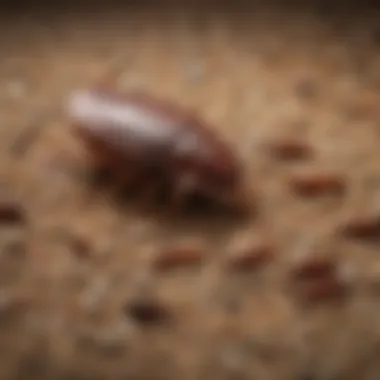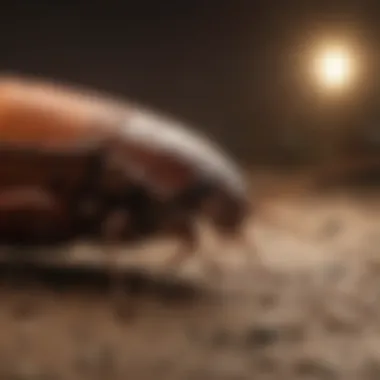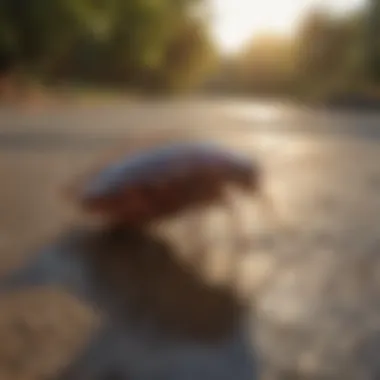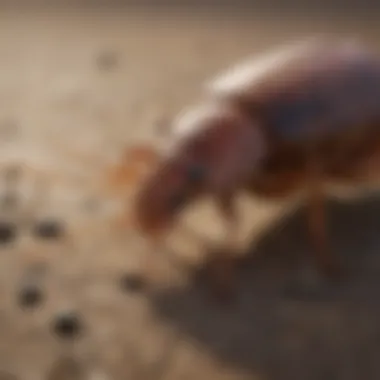Comprehensive Review of Dry Flowable Cockroach Bait


Intro
Pest control is a pressing concern for many homeowners, particularly when it involves resilient pests like cockroaches. Among various methods, dry flowable cockroach bait has emerged as a notable strategy in pest management. Understanding the composition, action mechanism, and application methods of this bait becomes critical for effectively dealing with infestations. This article aims to serve as a comprehensive guide for readers, providing insights into its efficacy, best practices, and the considerations one must take into account when opting for such treatments.
Pest Identification
Detailed Descriptions of Common Pests
Cockroaches are among the most common household pests, with several species frequently invading homes. The German cockroach, identifiable by its light brown color and two dark stripes on its back, is a common sight in kitchens and bathrooms. In contrast, the American cockroach is larger, boasting a reddish-brown hue and a more robust body. Other significant species include the Oriental cockroach, known for its shiny black appearance, and the brown-banded cockroach, recognized by its lighter, banded look.
Signs and Symptoms of Infestations
Detecting a cockroach infestation early can prevent severe issues in the long run. Common signs include:
- Droppings: Small, dark, cylindrical feces often found in kitchen areas or hidden corners.
- Egg Cases: Oval, brown casings indicating recent breeding.
- Musty Odor: A distinct smell can frequently be linked to cockroach presence.
- Sightings: Observing cockroaches, particularly during the night, is a clear indicator of an infestation.
Identifying these signs promptly allows for timely intervention and enhances the effectiveness of chosen pest control methods.
Prevention Strategies
Home Maintenance Tips for Pest Prevention
Maintaining a clean home is paramount in preventing cockroach infestations. Here are effective strategies to consider:
- Seal Entry Points: Use caulk to seal cracks and crevices around windows, doors, and electrical installations.
- Regular Cleaning: Keep surfaces free of crumbs and spills. Vacuum frequently, focusing on corners and hidden spaces.
- Food Storage: Store food in airtight containers and ensure garbage is disposed of properly.
Natural Deterrents and Barriers
Some natural deterrents can be implemented. Essential oils such as peppermint and tea tree oil possess properties that repel cockroaches. Placing bay leaves in cabinets and drawers can also serve as a natural barrier.
Treatment Options
Overview of Chemical vs. Natural Treatments
Various treatment options are available when dealing with cockroaches, categorized into chemical and natural treatments:
- Chemical treatments: Include dry flowable bait, which remains effective for targeting cockroach populations through ingestion. These products are often designed with specific active ingredients to eliminate the pest at its source.
- Natural treatments: Utilizes a more organic approach, using diatomaceous earth or boric acid. Though generally regarded as safer for households with children and pets, these may take longer to produce results.
Step-by-Step Guides for DIY Treatments
Implementing effective treatments can be straightforward. Here’s a simplified guide to using dry flowable cockroach bait:
- Identify Infested Areas: Conduct a thorough inspection to locate hotspots.
- Apply the Bait: Carefully place the bait according to the manufacturer's instructions, ideally in areas frequented by cockroaches.
- Monitor Results: Keep an eye on the bait area, adjusting placements as necessary.
The systematic application of pest control measures, particularly dry flowable cockroach bait, can significantly enhance the chances of eradication.
Finale
Dry flowable cockroach bait represents a nuanced approach to pest management that demands informed decisions. Homeowners must balance efficacy, safety, and practicality when applying these methods. By understanding both preparation and application, individuals can make strides in effectively controlling cockroach populations in and around their homes.
Foreword to Cockroach Control


Effective cockroach control is an essential aspect of maintaining a healthy living environment. Cockroaches are not only unpleasant to encounter; they are also potential carriers of diseases that can adversely affect the health of household members. Thus, understanding how to manage and eliminate these pests is crucial.
Importance of Cockroach Management
Cockroach management is vital for several reasons. First, these insects reproduce rapidly, leading to infestations that can overwhelm homes. Each female cockroach can produce hundreds of offspring in her lifetime, which can create challenges for homeowners. Moreover, cockroaches can trigger allergies and asthma, especially in children. Ingesting contaminated food or kitchen surfaces can also lead to various health issues.
Another important aspect lies in property value. A home plagued by pests can deter potential buyers, causing a significant impact on real estate value. Thus, effective cockroach management is not only about health; it also has economic implications.
Overview of Pest Control Strategies
Pest control strategies range from prevention to eradication. Homeowners often employ a combination of methods to manage cockroach populations effectively. Common strategies include:
- Sanitation: Keeping living spaces clean and food stored properly limits food resources for cockroaches.
- Exclusion: Sealing cracks and crevices helps to prevent cockroaches from entering homes.
- Chemical treatments: Products like dry flowable cockroach bait offer targeted solutions to infestations.
- Regular inspections: Frequent checks can help identify infestations early before they become a serious issue.
In summary, understanding and implementing effective cockroach control strategies is foundational to creating a safe and healthy home environment. Each method serves a purpose and can be adjusted to meet the specific needs of individual households.
Understanding Dry Flowable Cockroach Bait
Understanding dry flowable cockroach bait is crucial for effective pest control strategies. Unlike other bait forms, dry flowables offer unique advantages in both application and effectiveness. Their composition and mechanism of action set them apart, making them a valuable option for homeowners battling stubborn cockroach infestations.
Cockroaches are known for their resilience and adaptability, making effective management challenging. Therefore, selecting the right bait is essential. This section will delve into the chemical composition of dry flowable cockroach bait and explain how it functions to control these pests.
Chemical Composition
The chemical composition of dry flowable cockroach bait typically includes active ingredients such as insect growth regulators, neonicotinoids, or boric acid. These substances are chosen for their effectiveness against cockroaches while remaining relatively low in toxicity to humans and pets. The bait often contains a blend of attractants, which helps lure cockroaches to the product.
- Active Ingredients
- Attractants
- Carriers
- Insect Growth Regulators: These disrupt the normal growth and reproductive cycles of cockroaches.
- Neonicotinoids: This class of chemicals targets the nervous system of insects, leading to paralysis and death.
- Boric Acid: A long-standing pesticide, boric acid works by damaging the cockroach's exoskeleton and disrupting its digestive system.
- These are essential for ensuring cockroaches find and consume the bait. Ingredients like sugars or fats increase the bait's palatability, making it more likely cockroaches will ingest it.
- The dry flowable form requires carriers that help in even distribution. These may include components like clay or silica that aid in adhering the product to surfaces.
The blend of these elements contributes to the overall effectiveness of dry flowable cockroach bait. Understanding these components allows users to appreciate how they function against cockroach infestations while minimizing risks to humans and pets.
How Dry Flowable Bait Works
The effectiveness of dry flowable cockroach bait relies heavily on its mechanism of action. Once cockroaches consume the bait, several processes emerge that ultimately lead to population control. Here’s how it works:
- Ingestion
- Internal Disruption
- Domino Effect
- Cockroaches are drawn to the bait due to its attractants. They consume it while foraging for food.
- Following ingestion, the active ingredients act internally. For example, neonicotinoids interfere with nerve signaling, leading to paralysis. Insect growth regulators prevent the ability to mature into adult cockroaches.
- Cockroaches often return to their colonies after consuming the bait. This can lead to the unintentional sharing of the bait through feces or carcasses, enabling a broader impact on the population.
Key Insight:
The combination of attraction, ingestion, and internal disruption plays a vital role in reducing cockroach populations effectively.
The properties of dry flowable bait make it a valuable tool for homeowners looking to manage cockroach problems. Understanding how it works provides insight into its efficacy and the potential it holds within integrated pest management strategies.
Benefits of Using Dry Flowable Cockroach Bait


Dry flowable cockroach bait presents several compelling benefits that can enhance pest management efforts. Understanding these advantages is crucial for homeowners seeking effective and reliable methods to combat infestations. Each benefit contributes to the overall strategy of pest control, ensuring that the solutions are not only effective but also practical for daily use.
Effectiveness Against Cockroach Infestations
The primary strength of dry flowable cockroach bait lies in its effectiveness against various species of cockroaches. The bait works through a dual-action mechanism. First, cockroaches consume the bait and, subsequently, they carry it back to their nests, where it is shared with other colony members. This feature allows for a broader impact, as it reduces the population by targeting individuals that do not directly ingest the bait. Studies show that products like Advion Cockroach Gel and Spectracide Bug Stop have demonstrated significant efficacy in reducing cockroach numbers within a short period. This targeted approach means that infestations can be controlled swiftly, leading to a cleaner and healthier environment.
Ease of Application
Another notable benefit of dry flowable bait is the simplicity of its application. Homeowners can apply it in various settings, such as kitchens or basements, where cockroaches are frequently seen. The bait typically comes in a user-friendly format that makes it easy to measure and distribute. A small amount can be sprinkled in areas prone to infestations, such as behind appliances, under sinks, and near garbage areas. Furthermore, clean-up is manageable; because the bait is dry and not messy like liquids, it minimizes the time and effort needed for application. This ease of use makes it an appealing option for busy households.
Lower Risk to Human Health
Using dry flowable cockroach bait also presents a lower risk to human health compared to other pest control methods. Unlike traditional sprays that may contain harsh chemicals, dry bait is designed to be less harmful when used correctly. Most formulations have been developed to ensure safety in residential environments. They contain minimal volatile organic compounds (VOCs), reducing exposure risks. For families concerned about children or pets, dry flowable baits provide reassurance. With proper application and storage, these products minimize the chance of accidental ingestion or exposure, making them a safer choice for controlling cockroach populations.
"Effective pest control solutions must balance efficacy with safety. Dry flowable cockroach bait achieves this equilibrium."
In summary, the benefits of using dry flowable cockroach bait include its proven effectiveness against infestations, simple application process, and reduced health risks for households. Whether one is a seasoned pest control professional or a homeowner facing a cockroach problem, these advantages make dry flowable bait a strategic choice.
Application Methods for Dry Flowable Bait
The application methods for dry flowable cockroach bait are crucial for achieving optimal results in pest control. Proper techniques ensure that the bait is effective in attracting and eliminating cockroaches, thereby reducing infestations in residential and commercial spaces. Incorrect application can lead to wasted resources and increased pest problems. Understanding these methods helps homeowners adopt an efficient approach to pest management.
Preparation Before Application
Before applying dry flowable cockroach bait, specific preparations are necessary. First, identifying the infestation level is essential. Inspecting areas where cockroaches are commonly seen, such as kitchens and bathrooms, will provide insight into the severity of the problem. Secondly, cleaning the targeted areas is critical. This includes removing food particles, grease, and other debris. A clean environment allows the bait to work more effectively, as cockroaches are more likely to consume the bait instead of other food sources. Additionally, gathering the necessary tools and materials for the application process, such as gloves and a mask, can enhance safety and efficiency.
Proper Techniques for Application
Proper techniques for applying dry flowable bait can significantly affect its effectiveness. The bait should be evenly distributed in thin layers in areas where cockroaches are suspected. Using a small hand-held shaker or a similar tool can help achieve this. Avoid clumping, as this may deter cockroaches from consuming the bait. When applying the bait in corners or crevices, it's crucial to pay attention to where cockroaches tend to hide. Another key practice is to refrain from overusing the bait. Too much bait can lead to waste and potential resistance in cockroach populations.
Targeting Key Infestation Areas
Targeting key infestation areas is a strategic component of using dry flowable cockroach bait. Focus on places where cockroaches are likely to travel, such as along walls, under sinks, and near drains. Specific locations include:
- Behind appliances
- Inside cabinets
- Underneath sinks and counters
In addition, monitoring these areas regularly after applying the bait is essential. This allows homeowners to gauge the effectiveness of the treatment and make adjustments if necessary. Changing the bait's location can also help if cockroach activity continues in specific regions.
Effective application and targeting can significantly reduce an infestation.
In summary, preparing adequately and understanding the proper techniques for application can make a noticeable difference in the outcome of using dry flowable cockroach bait. By targeting key areas and adhering to best practices, homeowners will improve the chances of successful pest control.
Considerations and Limitations of Dry Flowable Cockroach Bait
When employing dry flowable cockroach bait, various factors must be considered to maximize effectiveness and minimize drawbacks. Understanding these limitations and considerations can help homeowners and pest control professionals make informed decisions about pest management strategies. While dry flowable bait offers several benefits, it is essential to address challenges that could affect its performance.
Environmental Impact
The environmental impact of dry flowable cockroach bait cannot be overlooked. Pesticides utilized in these baits can potentially enter the ecosystem if not managed properly. When applying these products, consider the following points:
- Non-target organisms: When spread in areas visible to pets or wildlife, non-target species may ingest the bait unintentionally. This can lead to unintended harm.
- Water contamination: If residues get into water systems, they can have detrimental effects on aquatic life. Therefore, it's vital to apply dry flowable bait away from water bodies.
- Soil considerations: Some chemical components may disrupt soil microbial communities, affecting plant health in the area.


Due to these factors, it is crucial to allow sufficient time between application and any interaction with the environment.
Potential Resistance in Cockroach Populations
Resistance is a well-documented challenge in pest control and can significantly hinder the effectiveness of dry flowable cockroach bait. As cockroach populations encounter specific chemicals, natural selection may lead to resistant individuals. This can result in:
- Diminished efficacy: Once a resistance profile establishes, the same bait may no longer yield results, leading to recurring infestations.
- Limitations in product selection: Pest control professionals may need to rotate between different active ingredients to combat resistance, complicating management strategies.
- Increased costs: The potential for ineffective treatments leads to more frequent applications and higher expenses over time.
Regular monitoring and assessment of cockroach populations can help understand resistance trends, guiding the choice of baits accordingly.
"Acknowledging both the environmental impact and resistance development is critical for sustainable pest management strategies."
Best Practices for Optimal Results
Understanding how to effectively utilize dry flowable cockroach bait is critical for achieving successful pest management. This section focuses on the best practices that homeowners and pest control professionals can adopt. Applying these methods can enhance efficacy and ensure a healthier living environment. It provides a systematic approach toward understanding the various techniques that can be employed for improved outcomes.
Combining Methods for Integrated Pest Management
Integrated Pest Management (IPM) is a holistic approach to pest control that synthesizes different strategies and practices. In the case of cockroach infestations, combining dry flowable bait with other methods can yield superior results. This combination not only increases effectiveness but also minimizes reliance on a single method, which can help reduce the risk of cockroach populations developing resistance.
There are several strategies to consider:
- Sanitation: Maintaining cleanliness is essential. Regularly clean kitchen areas, dispose of food waste, and remove clutter to eliminate hiding spots for cockroaches.
- Exclusion: Block entry points in your home. Check for cracks or gaps in walls, around doors, and windows, and seal them properly.
- Monitoring: Place monitors to assess cockroach activity. This helps in determining the optimal application areas for the dry flowable bait.
- Comparative Methods: Assess the effectiveness of dry flowable bait with gel-based baits or other insecticides. This can provide insightful data on which approach yields the best results for your specific situation.
By utilizing these combined methods, you can create a more robust defense against cockroaches, making your efforts with dry flowable bait much more effective.
Regular Monitoring and Maintenance
Continuous monitoring and maintenance play a vital role in the effective use of dry flowable cockroach bait. Once the bait is applied, it is necessary to regularly check its status and the level of cockroach activity. This helps identify whether further intervention is needed.
Here are some key practices to follow for effective monitoring:
- Assess Bait Consumption: Check the bait stations periodically to see if the bait has been consumed. If it remains untouched, it may indicate a need to change the bait location or choose a different formulation.
- Record Observations: Keep a log of any sightings or signs of cockroach activity. This will help in evaluating the ongoing effectiveness of the bait and allow for any necessary adjustments.
- Evaluate Environmental Changes: Make a note of any changes in the environment, such as shifts in humidity or temperature, that may influence cockroach behavior. Adapt your strategies accordingly.
Regular maintenance ensures that the bait remains effective and that control strategies are adjusted based on the current situation.
"Effective pest management requires vigilance. Be proactive in your approach to ensure a better long-term outcome."
By employing these best practices, individuals can fortify their defenses against cockroaches, combining science with vigilance to ensure effective pest control.
The End
A comprehensive understanding of dry flowable cockroach bait is essential for effective pest management. As highlighted in this article, these baits provide a strategic and targeted approach to combating cockroach infestations. Their chemical composition and mechanism of action are carefully engineered to attract and eliminate cockroaches whilst minimizing risks to humans and pets.
Recap of Key Insights
In summary, dry flowable cockroach bait proves to be an effective solution for managing cockroach populations. Notably, its effectiveness anchors on its specific formulation, which allows it to remain palatable to these pests. Moreover, its ease of application empowers homeowners, allowing them to take proactive measures against infestations.
Some crucial insights include:
- Effectiveness: These baits have shown reliable results in controlling cockroach populations, significantly reducing the chances of recurring infestations.
- Ease of Use: The application process is straightforward, making it accessible for individuals unfamiliar with pest control methods.
- Safety Considerations: This bait formulation is designed to pose lower health risks to humans and non-target species.
"Understanding the advantages and limitations of dry flowable cockroach bait allows users to optimize their pest control strategies and protect their environments effectively."
Future Directions in Cockroach Control Research
The field of cockroach control is ever-evolving. Future research must continue to focus on developing more effective baits while addressing the limitations observed today. This includes exploring new formulations that are less likely to create resistance among cockroach populations. Enhanced knowledge of behavioral patterns can lead to better-targeted bait strategies.
Additionally, studies should investigate the environmental impacts of various pest control substances, ensuring long-term sustainability in pest management practices. Understanding the dynamics of urban ecosystems can help align pest control measures with environmental stewardship.



